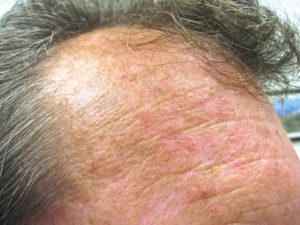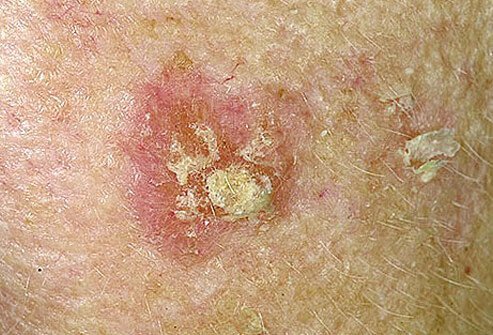A diagnosis of Actinic Keratosis is a Pre-cancerous form of Skin Cancer- Lower Your Risk of AK Becoming Skin Cancer with Evidence-based, Non-toxic Therapies
I am a cancer survivor who has 6 of the risks listed below for Non-Melanoma Skin Cancer (NMSC). I had a mole (nevis) removed from my face a few years ago. The dermatologist said that the pathology of the mole (biopsy) was “undetermined.”
After undergoing aggressive chemotherapies and radiation, I am at an increased risk of skin cancer and I sat in the sun much too often as a teen so I worry about my skin these days.
As you can read below, pre-skin cancer is multi-faceted and somewhat confusing. And is the most frequently diagnosed pre-cancer in the United States annually.

Ed. Note- 10 years after writing this post, I had another 3 suspicious moles removed and biopsied. No NMSC or melanoma found. I also had two dark-ish patches on my bald head cryotherapied. Frozen.
So when faint brown patches began to appear magically on my head I decided to learn more about skin cancer. AK is classified as a skin disease at this point but they are patches of pre-skin cancer that are heading in the direction of skin cancer as far as I can tell. My head looks just like the photo to the left.
Further the more advanced AK gets the more noticeable it becomes. As the linked information below explains, there is a good chance my AK will progress and/or recur.
What the article about AK interventions linked below- doesn’t discuss are evidence-based but non-conventional forms of therapy. Botanicals that not only reduce your risk of full blown skin cancer but therapies that can actually heal the damage done by years of U.V. radiation aka sunlight.
If you have one or more AK’s, especially on your face and are thinking through how best to remove it/them, be sure to learn about possible side effects aka adverse events.
To Learn More about Actinic Keratotis- read the posts linked below-
Non-Melanoma Skin Cancer at a Glance-
- Risks– UV Exposure, HPV, Genetics, Skin Pigment, Immunosuppression, Radiation Therapy, Age, Previous Skin Cancer,
- Symptoms– Itching, Bleeding, Shape (A,B,C,D,E).
- Diagnosis– Visual inspection (A,B,C,D,E), Skin Biopsy (Shave, Punch, Incisional/Excisional)
- Prognosis- Staging-
- Therapy– Conventional, Non-Conventional, Integrative, Alternative
Do you have actinic keratosis. basel cell or squamous cell carcinoma? Scroll down the page, post a question or comment and I will reply to you ASAP.
Thank you,
David Emerson
- Cancer Survivor
- Cancer Coach
- Director PeopleBeatingCancer
Recommended Reading:
Prognosis-AKs follow one of three paths: they can either persist as AKs, regress, or progress to invasive skin cancer, as AK lesions are considered to be on the same continuum with squamous cell carcinoma (SCC). AK lesions that regress also have the potential to recur.
- Progression: The overall risk of an AK turning into invasive cancer is low. In average-risk individuals, likelihood of an AK lesion progressing to SCC is less than 1% per year.[71][72] Despite this low rate of progression, studies suggest that a full 60% of SCCs arise from pre-existing AKs, reinforcing the idea that these lesions are closely related.[71][72]
- Regression: Reported regression rates for single AK lesions have ranged between 15–63% after one year.[73]
- Recurrence: Recurrence rates after 1 year for single AK lesions that have regressed range between 15–53%.[73]
“Actinic keratoses are a skin disease caused by long-term sun exposure. Damaged skin shows small, red, rough, scaly, flat spots called actinic keratoses or lesions, which feel like patches of dry skin. Symptoms such as bleeding and pain can be associated with actinic keratoses. Moreover, actinic keratoses have the potential to develop into skin cancer if left untreated.
The reasons for treatment may include cosmetic appearance, relief of symptoms, or prevention of skin cancer. Treatment can be directed either at individual lesions or to larger areas of the skin where several visible and less visible lesions occur (field-directed treatment).
This systematic review included results from 83 randomised controlled clinical trials evaluating 24 treatments, with a total of 10,036 participants diagnosed with actinic keratosis.
We included 18 topical creams or gels applied to a skin area by the participants:
- adapalene gel,
- aretinoid methyl sulfone (Ro 14-9706),
- betulin-based oleogel,
- calcipotriol (vitamin D),
- colchicine,
- diclofenac,
- 2-(difluoromethyl)-dl-ornithine (DFMO),
- 5-fluorouracil,
- ß-1,3-D-glucan,
- imiquimod,
- ingenol mebutate (PEP005),
- isotretinoin,
- masoprocol,
- nicotinamide,
- resiquimod,
- sunscreen,
- DL-α-tocopherol (vitamin E),
- and tretinoin.
One treatment, etretinate, was taken orally. Clinical staff administered two mechanical treatments (carbon dioxide and Er:YAG laser resurfacing) on a skin area, and they administered three chemical treatments: cryotherapy on individual lesions, photodynamic therapy on individual lesions or a skin area, and trichloroacetic acid peel on a skin area.
The clinical effects resulting from the treatment of actinic keratoses were reported differently from one study to another.
In spite of this inconsistency, it can be concluded that several good treatment options exist for the treatment of actinic keratoses. Actinic keratoses were successfully treated with cryotherapy, diclofenac, 5-fluorouracil, imiquimod, ingenol mebutate, photodynamic therapy, resurfacing, and trichloroacetic acid peel.
These different treatments were generally comparably effective. Skin irritation was associated with some of these treatments, such as diclofenac and 5-fluorouracil, but other side-effects were uncommon. The final cosmetic appearance varies from one treatment to another. Imiquimod treatment and photodynamic therapy resulted in better cosmetic appearance than treatment with cryotherapy and 5-fluorouracil.
Treatment with photodynamic therapy gives better therapeutic and cosmetic results than cryotherapy for individual lesions. For field-directed treatments, diclofenac, 5-fluorouracil, imiquimod, and ingenol mebutate are good options associated with different side-effects and cosmetic results. Thus, the choice of treatment option for actinic keratosis depends on the number of lesions, the individual’s desired results, and tolerance to the treatments.




